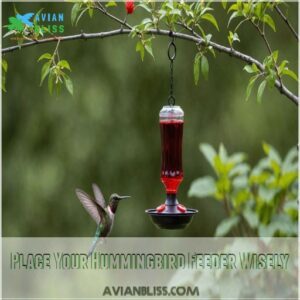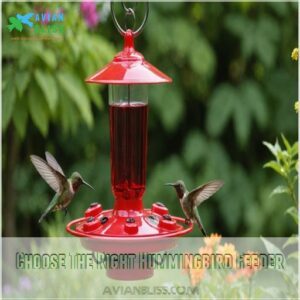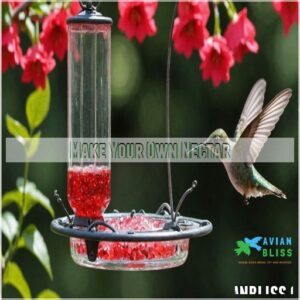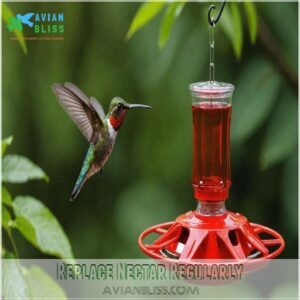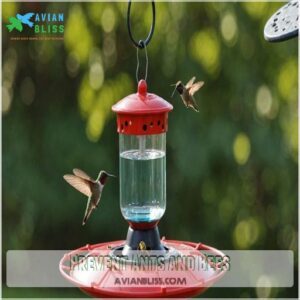This site is supported by our readers. We may earn a commission, at no cost to you, if you purchase through links.
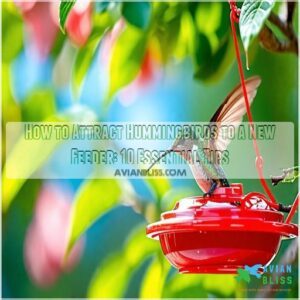
Make your own nectar using a simple 4:1 water-to-sugar ratio; avoid dyes. Regular cleaning is key to prevent spoilage and unwanted guests. Consider adding an ant moat for extra protection.
Remember patience; it might take a few days for them to discover your delicious offering. Want to learn more about creating a hummingbird haven? There’s a whole lot more we can cover…
Table Of Contents
- Key Takeaways
- Place Your Hummingbird Feeder Wisely
- Choose The Right Hummingbird Feeder
- Make Your Own Nectar
- Replace Nectar Regularly
- Keep Your Feeder Clean
- Prevent Ants and Bees
- Hang Multiple Feeders
- Create a Hummingbird-Friendly Garden
- Provide Perching and Hiding Areas
- Be Patient and Observe
- Frequently Asked Questions (FAQs)
- How to attract hummingbirds?
- How do I attract hummingbirds to my feeder?
- How to choose a hummingbird feeder?
- Do hummingbirds visit a feeder?
- How do I get hummingbirds to see my feeder?
- How do you keep hummingbirds in a bird feeder?
- How long does it take for hummingbirds to find a new feeder?
- How do I get my hummingbirds to come to my new feeder?
- Where should you not hang a hummingbird feeder?
- What is the secret to attracting hummingbirds?
- How do I make my yard appealing to hummingbirds?
- What time of year do hummingbirds migrate?
- Can hummingbirds recognize different food sources?
- What colors do hummingbirds find most attractive?
- How can I keep wasps away from the feeder?
- Conclusion
Key Takeaways
- Choose a bright red feeder and hang it in a shaded, visible spot about 5-6 feet off the ground near flowers or shrubs.
- Make your own nectar using a 4:1 ratio of water to white sugar, boil it to prevent spoilage, and avoid using red dye or artificial sweeteners.
- Clean your feeder regularly with vinegar and water, and replace the nectar every 4-5 days, especially in warm weather.
- Be patient and observant – it may take time for hummingbirds to discover and trust your feeder, but once they do, you’ll enjoy their frequent visits.
Place Your Hummingbird Feeder Wisely
Positioning your hummingbird feeder correctly is key to attracting these fascinating little birds.
Make sure to hang it near flowers or shrubs and at least 4 feet off the ground to give them a safe, inviting spot to sip nectar.
Choose a Feeder Location Near Flowers and Shelter
To attract hummingbirds, place your feeder near blooming flowers and shelter, creating a mini hummingbird paradise.
They love spots with vibrant colors and safe perching areas.
Mix native plants into your hummingbird garden to naturally entice them while blooming beauties keep them coming back.
Think of it as setting up a hummingbird buffet with a view!
Hang The Feeder at Least 4 Feet Off The Ground
Position your hummingbird feeder strategically, considering the best height and visibility that’s typically 5 to 6 feet off the ground, as recommended for top hummingbird feeders.
Hanging it at least four feet high improves pest prevention and height safety.
This helps the feeder stay stable, keeping those tiny acrobats safe.
Better visibility from this height helps attract hummingbirds.
Plus, it’s easier to maintain and refill without constantly bending over.
A happy hummingbird is a frequent visitor!
Choose The Right Hummingbird Feeder
To attract hummingbirds in a flash, choosing the right feeder is key—think of it like picking the perfect party venue.
Opt for a feeder with a bright red base to catch their eye.
Make sure it’s easy to clean, so you don’t end up spending your summer scrubbing sugar spots.
Select a Feeder With a Red Base or Top
Seeing those tiny hummingbirds flock to your feeder can be magical.
Choose a feeder with a red base or top for best results.
You can also find a variety of red hummingbird feeders online, such as at the red hummingbird feeder store.
- Red Feeder Benefits: Attracts hummingbirds like bees to honey.
- Hummingbird Color Vision: They love vivid reds.
- Feeder Design Impact: Red enhances the appeal.
- Red Feeder Alternatives: Combine red flowers to boost attraction.
Happy hummingbird watching!
Consider a Feeder With a Built-in Ant Moat
Choosing a feeder with a red top attracts hummingbirds, but incorporating a simple ant deterrent method, such as using a hummingbird feeder with a built-in ant moat solution, can also keep pests away.
Imagine ants holding a swim meet in your moat, never reaching the nectar!
An ant moat is an effective way to prevent ants in hummingbird feeder, a common issue many bird enthusiasts face.
To keep your hummingbird feeder trouble-free, using a dish feeder with built-in ant moats and nectar guards can help prevent pests from accessing the nectar. It’s a simple yet smart addition, keeping your feathery friends happy and your hummingbird feeders trouble-free.
| Feature | Benefit | Notes |
|---|---|---|
| Built-in Ant Moat | Prevents ant access | Effective against ants |
| Water Barrier | Pest deterrent | Easy maintenance |
| Keeps Nectar Safe | Enhances enjoyment | Essential for hummingbird feeders |
Choose a Feeder That is Easy to Clean
Let’s face it, nobody enjoys endless scrubbing, right?
Pick an easy-clean feeder to save time and effort.
Avoid messy disasters by choosing designs that simplify hummingbird feeder maintenance:
- Wide openings for quick rinses
- Smooth surfaces that resist gunk
- Dishwasher-safe parts for hassle-free cleaning
- Detachable components for thorough upkeep
With these cleaning tips, you’ll spend more time watching than washing.
Make Your Own Nectar
Creating your own hummingbird nectar is both simple and satisfying, giving you the peace of mind that comes from knowing exactly what’s feeding these tiny marvels.
Just mix four parts water with one part white granulated sugar, and skip the red dye—your feathered friends are more interested in the tasty treat than its color.
Use a 4:1 Ratio of Water to White Granulated Sugar
Imagine this: a simple 4:1 water to sugar ratio transforms your backyard into a hummingbird haven.
Mix water and white granulated sugar, and let the magic begin.
They’ll zip to and fro, loving your homemade nectar.
Consider this recipe a friendship potion for these delightful birds.
| Sugar Type | Water Ratio | Hummingbird Visits |
|---|---|---|
| White | 4:1 | |
| Brown | Avoid | |
| Honey | Avoid | |
Boil and Cool The Mixture to Prevent Spoilage
After mixing your sugar water, bring it to a rolling boil on the stovetop.
This important step kills off any unwanted bacteria, preventing nasty nectar fermentation and keeping your hummingbird friends healthy.
Then, let it cool completely before filling your hummingbird feeders.
Here’s why this is so important:
- Prevents spoilage.
- Maintains the right sugar water temperature.
- Keeps hummingbirds healthy.
Avoid Using Red Food Dye and Artificial Sweeteners
You’ve boiled and cooled your nectar, so skip the red food dye and artificial sweeteners next.
They sound harmless but pose dye dangers to hummingbird health, with some countries even banning red dye in nectar due to potential health risks.
Opt for natural nectar, using a 4:1 water to sugar ratio.
It’s like homemade hummingbird food!
This simple sugar water keeps your feeder safe and those charming visitors happy and healthy.
Replace Nectar Regularly
Regularly replacing nectar is key to keeping your hummingbird friends healthy and happy.
Hummingbirds can be fussy guests, and spoiled nectar quickly turns them away.
Here’s a handy guide:
- Change Frequency: Replace sugar water every 4-5 days, especially in warm weather, to fend off fermentation.
- Watch the Weather: Adjust the replacement schedule if temperatures rise, as spoilage speeds up with heat.
- Check for Spoilage: Look for signs like a cloudy appearance or an off smell—if it doesn’t seem right, it’s time for fresh nectar.
By swapping out old nectar regularly, you’re ensuring your colorful visitors keep returning for more.
Happy feeding means happy hummingbirds, so keep that sugar water recipe handy and stay on schedule!
Keep Your Feeder Clean
To keep the feeder clean, it’s essential to follow a regular sterilization routine, such as using a vinegar solution cleaner. Keeping your feeder clean is essential to make sure your hummingbird visitors stay healthy and happy, as it prevents mold and impurities from spoiling their sweet treat.
A quick rinse with vinegar and water is your ally here, plus it helps keep ants and bees at bay, allowing you to enjoy the charm of these tiny creatures without insect interference.
Clean Your Feeders Regularly With Vinegar and Water
When hummingbirds are your guests, a clean feeder speaks volumes.
Use a vinegar and water cleaning solution to scrub away grime and fend off mold.
Do this every few days, especially in warm weather.
It’s like giving your feeder a spa day!
Selecting easy-to-clean types and using the right tools simplifies the task, ensuring fresh sugar water delights your feathered friends.
Prevent Ants and Bees From Accessing The Feeder
Ants and bees love sugar water as much as hummingbirds do, but you can outsmart them easily.
Try these tricks to maintain a peaceful feeder:
To specifically address the issue of bees, consider choosing the right feeder design and placement, such as selecting feeders with long, narrow tubes for hummingbirds.
Install an ant moat to drown those tiny invaders without squashing your mood.
Opt for bee guard types that’ll block buzzing visitors.
Experiment with natural deterrents like cinnamon oil.
Position feeders wisely to minimize pest attraction.
Prevent Ants and Bees
Keep ants and bees at bay, or your feeder might turn into a snack bar for unwanted guests.
Use an ant moat to thwart ant invasions and a bee guard to keep those buzzing nectar lovers at a distance.
Use an Ant Moat to Prevent Ants
Keeping your feeder clean is half the battle, but now let’s talk ants!
An ant moat is your secret weapon.
These clever little water barriers, whether store-bought or homemade, stop ants dead in their tracks.
Regular moat maintenance is key; topping it off with fresh water keeps those sugar-loving invaders away.
You’ll find various ant moat types available, so choose one that fits your hummingbird feeder.
This simple step makes sure your sweet nectar stays hummingbird-only!
Use a Bee Guard to Prevent Bees
Imagine lounging in your garden, watching hummingbirds zip around, only to be interrupted by swarming bees.
A bee guard is your solution!
Place it on your feeder, and select from various bee guard types designed to deter unwelcome visitors.
They’re effective and allow hummingbirds to feed peacefully.
While bees play their part in nature, keeping them off your feeder preserves that enchanting view.
Hang Multiple Feeders
Hanging multiple feeders gives hummingbirds plenty of options and reduces competition among them, preventing any aggressive bird from hogging the nectar.
By placing these feeders at varying distances, you’ll create a welcoming buffet that accommodates multiple birds, ensuring everyone gets a fair share and maybe even some gossip.
Hang Multiple Feeders to Prevent Aggressive Hummingbirds
Tame hummingbird aggression by hanging multiple feeders.
This clever strategy reduces competition for food and lessens territorial behavior among these vibrant visitors.
By spacing out your hummingbird feeders, you’re creating a peaceful habitat where even the most aggressive hummingbirds, known to fiercely defend their territorial food sources, can coexist.
You’ll enjoy a delightful display, reminiscent of a birdy block party, filled with flitting colors and the gentle hum of wings.
Place Feeders at Varying Distances to Accommodate Multiple Birds
To curb hummingbird aggression, place feeders at varying distances.
This tactic supports bird diversity and minimizes feeder competition.
You can also find products specifically designed for hummingbird feeder spacing to help you achieve the perfect setup.
You’ll notice a calm among territorial birds, like a playground with plenty of swings.
Here are some tips:
- Space feeders about 10 feet apart.
- Add bird perches nearby.
- Mix locations: sun and shade.
- Rotate feeder spots occasionally.
Create a Hummingbird-Friendly Garden
To create a hummingbird-friendly garden, start by planting vibrant native flowers that hummingbirds adore, such as bee balm and penstemons.
These tiny birds can’t resist the sweet nectar from long, tubular blooms, so you’re basically setting up a five-star buffet they can’t ignore!
Plant Native Flowers That Hummingbirds Love
Transform your backyard into a hummingbird haven by planting native flower types that these little aviators adore.
Choose blossoms with vibrant colors—especially reds and oranges—to catch their eye.
Consider planting honeysuckle and other favorites during the best planting times to guarantee steady bloom times.
This creates a dynamic hummingbird habitat, adding life and joy to your garden while naturally supporting pollinators.
Choose Long, Tubular Flowers That Hold More Nectar
Want hummingbirds in your garden? Plant deep, tubular flowers!
These nectar-rich blooms, like foxgloves and red columbine, are perfect for their long beaks.
Think of it as a hummingbird-sized buffet!
These hummingbird flower types offer extended flower lifespan, benefiting both the birds and your beautiful birdfriendly plants.
Plus, they’re less accessible to pesky insects.
Creating a hummingbirdfriendly garden is easier than you think!
Provide Perching and Hiding Areas
To make your yard irresistible to hummingbirds, provide them with perching and hiding areas where they can rest and feel safe.
Adding a snag perch with a dead branch or a misting system can turn your garden into a hummingbird haven that they just can’t resist, offering both relaxation and a bit of fun.
Create a Snag Perch With a Dead Branch
Plants that hummingbirds adore aren’t the only tricks up your sleeve.
Picture a playful snag perch using a dead branch—nature’s own art installation.
Perfect for perching, it offers safety and resting areas.
Choose a sturdy branch for your perch design, thinking about its placement to attract birds.
A little woodworking humor—hummingbirds might just appreciate your snag’s rustic charm!
Consider Adding a Misting System
Just as a dead branch can become a cozy perch, a misting system creates a cool oasis for hummingbirds.
These lively creatures adore the fine spray, which mimics rain and helps them cool off.
You can find a variety of Hummingbird mister systems online to suit your needs.
Opt for a DIY misting system or store-bought misters to meet their water needs.
Remember, adding drippers can further enhance your wildlife gardening appeal.
Be Patient and Observe
Be patient as hummingbirds need time to discover and trust your yard, much like a new friend at a party who needs a little coaxing.
As you watch them zip around, you’ll begin to understand their preferences, which can help make your feeder a favorite stop.
Wait for Hummingbirds to Discover and Trust Your Yard
You’ve set up perching and hiding spots; now, let the magic of patience unfold!
Hummingbirds arriving in your yard need time to trust their new environment.
Imagine them hesitantly circling as they check things out.
Embrace the wait by:
- Enjoying coffee on your porch
- Chatting with neighbors about birds
- Relishing quiet moments
- Reading a good book outside
- Observing nature’s dance
Observe Hummingbirds to Learn Their Preferences
Curiosity often leads to success as you observe their antics.
Notice their feeding habits and favorite flowers.
Keep an eye on flight patterns and territorial behavior—it’s like a ballet in your backyard!
Even consider adding hummingbird-friendly water features.
Soon, you’ll tune into their rhythms, as bird watching transforms your garden into a stage where nature’s performers steal the spotlight.
Frequently Asked Questions (FAQs)
How to attract hummingbirds?
Picture your garden as a colorful stage where hummingbirds perform their aerial dance.
Hang bright feeders, use a sugar-water mix, plant red blossoms, and avoid pesticides.
These tiny gems will transform your yard into a lively spectacle.
How do I attract hummingbirds to my feeder?
Change your feeder’s location to a shaded spot.
Hummingbirds in Michigan, including the Ruby-throated Hummingbird, are attracted to feeders with clean, fresh nectar and multiple feeding ports, as described in the guide to Hummingbirds in Michigan. Red feeders attract hummingbirds.
Fill it with nectar made from one part sugar to four parts water.
Regularly change the nectar and clean the feeder to prevent mold.
How to choose a hummingbird feeder?
To attract hummingbirds to a new feeder, consider using a simple sugar-water solution in a nectar feeder, as hummingbirds are attracted to these types of feeders. Choose a hummingbird feeder with a red base to attract birds easily.
Make sure it’s easy to clean, prevents leaks, and includes bee guards and ant moats.
Opt for a dish-style design to keep bees out.
Do hummingbirds visit a feeder?
If you hang a nectar-filled feeder, hummingbirds will visit like clockwork seeking that sweet, sugary fix.
They love bright, red colors and familiar spots, often returning to the same feeders until emptied or moved.
How do I get hummingbirds to see my feeder?
Place your feeder near vibrant red flowers and hang some red tape around it.
To make it more enticing, keep it shaded, use sweet nectar, and be patient.
Hummingbirds will eventually discover your inviting setup!
How do you keep hummingbirds in a bird feeder?
Keep your feeder full of fresh, sugar-water nectar; clean it regularly. Bright red feeders near flowers attract them. Patience is key; they’ll find it eventually!
How long does it take for hummingbirds to find a new feeder?
Sarah hung her new feeder in April, but it took two weeks for a curious hummingbird to appear.
On average, you’ll wait a few days to several weeks.
Be patient and consistent with fresh nectar to increase your chances.
How do I get my hummingbirds to come to my new feeder?
To attract hummingbirds to your new feeder, hang it near bright flowers and use a 4:1 water-to-sugar ratio for nectar.
Be patient; it may take time.
Keep the feeder clean and full to encourage regular visits from these tiny, energetic birds.
Where should you not hang a hummingbird feeder?
When placing your hummingbird feeder, consider optimal feeder placement strategies to ensure visibility and accessibility. Avoid hanging hummingbird feeders in direct sunlight, near windows, or in areas with high pest activity.
Don’t place them too close to dense foliage, where predators might lurk.
Also, steer clear of windy spots that could make feeding difficult for these tiny birds.
What is the secret to attracting hummingbirds?
The secret’s in the sweet stuff!
Whip up a nectar buffet with bright red feeders and vibrant flowers.
Keep it clean and consistent, and you’ll have these flying jewels buzzing around in no time.
It’s nature’s own magic trick!
How do I make my yard appealing to hummingbirds?
Transform your yard into a hummingbird haven!
Plant vibrant, tubular flowers like bee balm and columbines.
Hang nectar feeders in shaded spots, add a water feature, and create perching areas.
You’ll soon have these tiny acrobats zipping around!
What time of year do hummingbirds migrate?
Hummingbirds typically migrate in spring and fall.
You’ll spot these tiny travelers heading north from February to May, and southbound from July to October.
Their exact timing varies by species and location, so keep your eyes peeled!
Can hummingbirds recognize different food sources?
Hummingbirds have incredible memory and can recognize different food sources.
They’ll remember your feeder’s location and return to it.
These smart little flyers can even distinguish between sugar concentrations, preferring sweeter nectar when available.
What colors do hummingbirds find most attractive?
Research confirms hummingbirds are drawn to vibrant hues.
Red’s their top pick, but orange and pink also catch their eye.
They’re partial to long, tubular flowers in these shades.
Surprisingly, they can see ultraviolet light, making colors pop even more.
How can I keep wasps away from the feeder?
Keep wasps at bay by using feeders with bee guards or small feeding ports.
Opt for dish-style feeders, which wasps find tricky to access.
Regularly clean up spills and consider hanging a separate wasp trap nearby to divert their attention.
Conclusion
Did you know that hummingbirds can visit up to 2,000 flowers in a single day?
By following these tips on how to attract hummingbirds to a new feeder, you’re not just offering them a snack—you’re creating a key pit stop in their busy lives.
Remember, patience is key.
It might take time, but once these tiny dynamos discover your feeder, you’ll be treated to a mesmerizing display of aerial acrobatics.
So hang that feeder, mix up some nectar, and get ready for nature’s own miniature air show!

